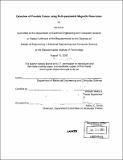Detection of prostate cancer using multi-parametric magnetic resonance
Author(s)
Chan, Ian, 1978-
DownloadFull printable version (4.958Mb)
Other Contributors
Massachusetts Institute of Technology. Dept. of Electrical Engineering and Computer Science.
Advisor
William Wells, III.
Terms of use
Metadata
Show full item recordAbstract
A multi-channel statistical classifier to detect prostate cancer was developed by combining information from 3 different MR methodologies: T2-weighted, T2-mapping, and Line Scan Diffusion lmaging(LSDI). From these MR sequences, 4 sets of image intensities were obtained: T2-weighted(T2W) from T2-weighted imaging, Apparent Diffusion Coefficient(ADC) from LSDI, and Proton Density (PD) and T2 (T2Map) from T2-mapping imaging. Manually- segmented tumor labels from a radiologist were validated by biopsy results to serve as tumor "ground truth." Textural features were derived from the images using co-occurrence matrix and discrete cosine transform. Anatomical location of voxels was described by a cylindrical coordinate system. Statistical jack-knife approach was used to evaluate our classifiers. Single-channel maximum likelihood(ML) classifiers were based on 1 of the 4 basic image intensities. Our multi-channel classifiers: support vector machine (SVM) and fisher linear discriminant(FLD), utilized 5 different sets of derived features. Each classifer generated a summary statistical map that indicated tumor likelihood in the peripheral zone(PZ) of the gland. To assess classifier accuracy, the average areas under the receiver operator characteristic (ROC) curves were compared. Our best FLD classifier achieved an average ROC area of 0.839 (±0.064) and our best SVM classifier achieved an average ROC area of 0.761 (±0.043). The T2W intensity maximum likelihood classifier, our best single-channel classifier, only achieved an average ROC area of 0.599 (± 0.146). Compared to the best single-channel ML classifier, our best multi-channel FLD and SVM classifiers have statistically superior ROC performance with P-values of 0.0003 and 0.0017 respectively from pairwise 2-sided t-test. By integrating information from the multiple images and capturing the textural and anatomical features in tumor areas, the statistical summary maps can potentially improve the accuracy of image-guided prostate biopsy and enable the delivery of localized therapy under image guidance.
Description
Thesis (M.Eng.)--Massachusetts Institute of Technology, Dept. of Electrical Engineering and Computer Science, 2002. Includes bibliographical references (leaves 26-28).
Date issued
2002Department
Massachusetts Institute of Technology. Department of Electrical Engineering and Computer SciencePublisher
Massachusetts Institute of Technology
Keywords
Electrical Engineering and Computer Science.